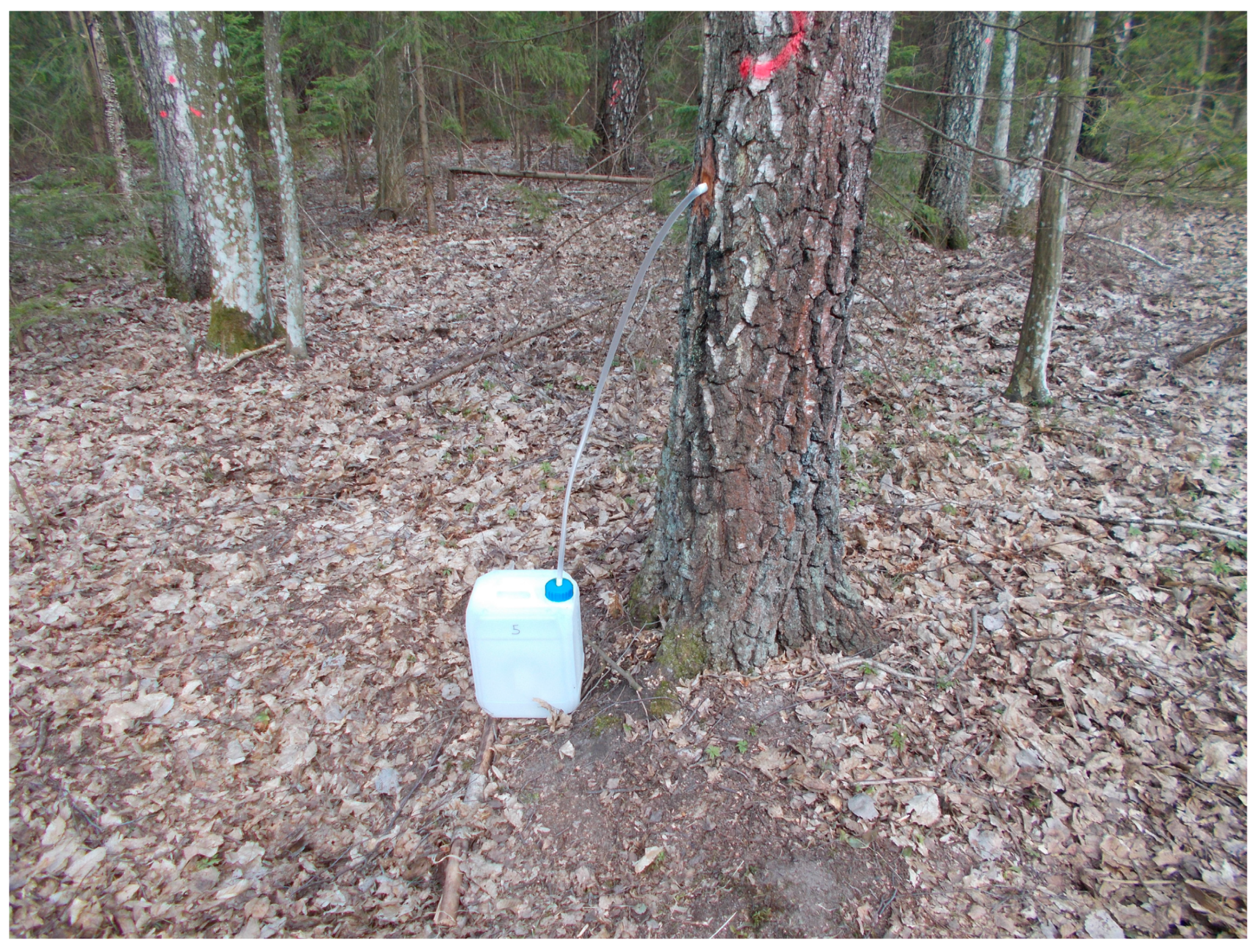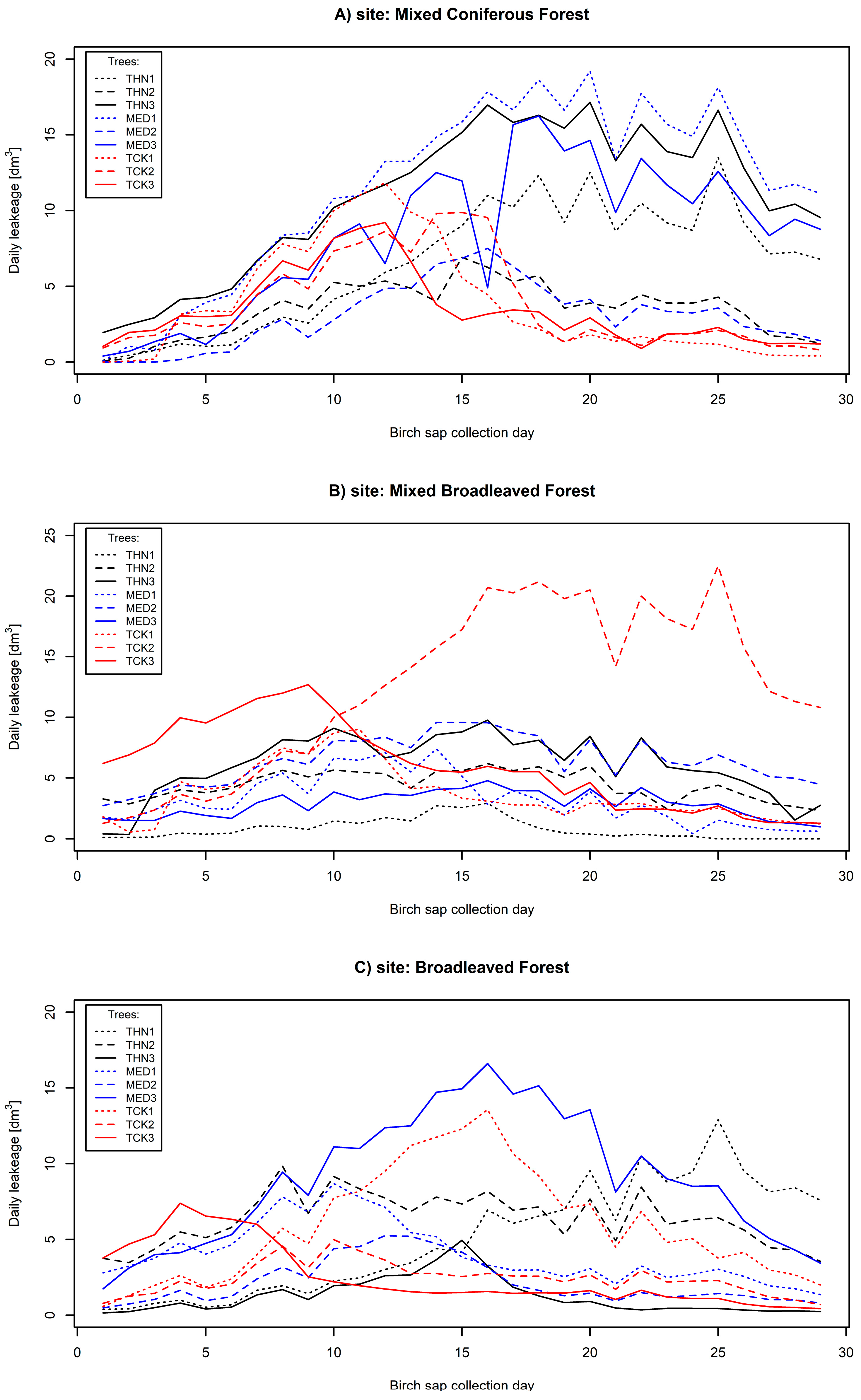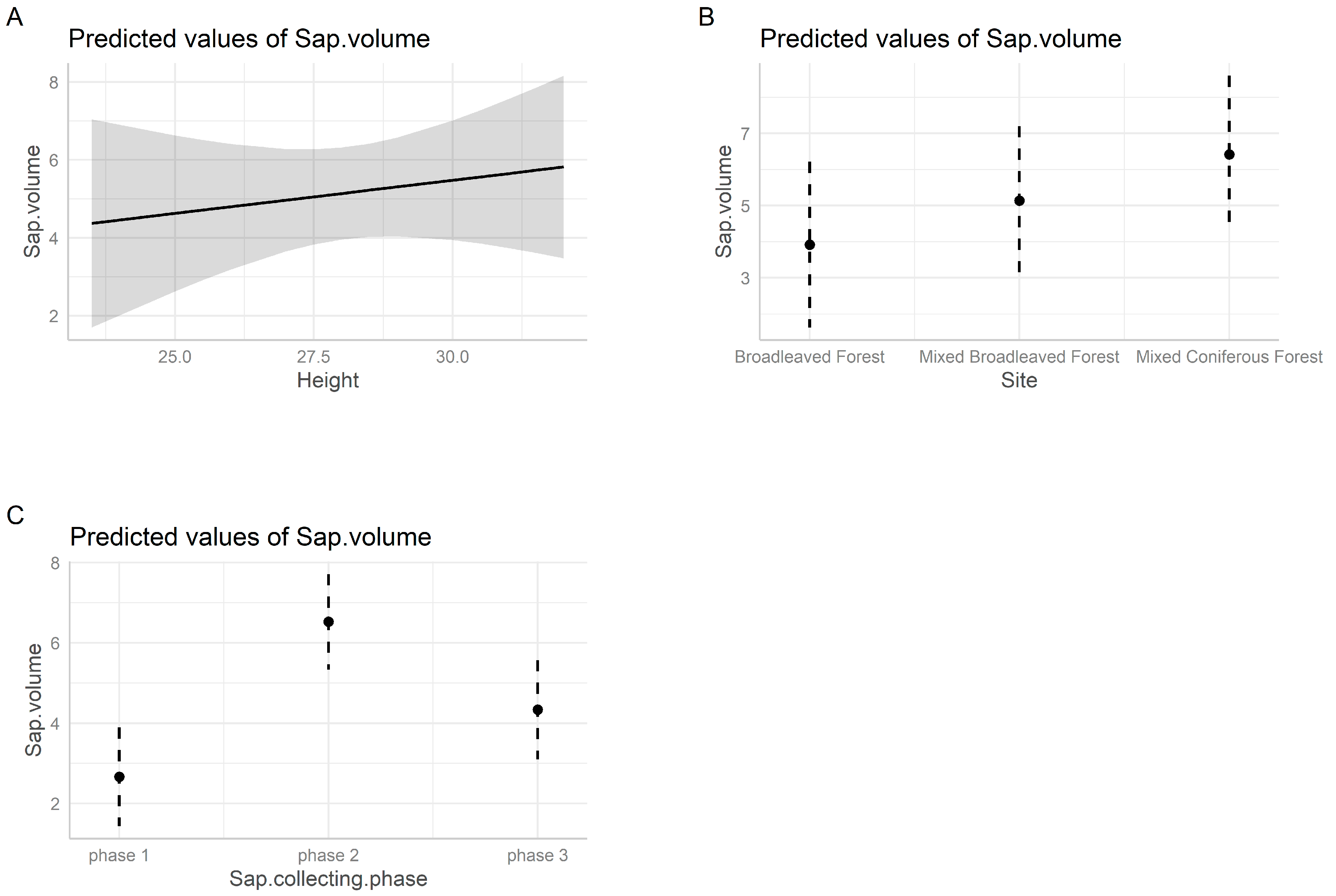The Relationship Between Biometric Features of Trees and the Intensity of Birch Sap Leakage in Various Forest Sites
Abstract
1. Introduction
- –
- There is a relationship between the biometric features of trees (such as diameter at breast height, total height, crown base, crown length, relative crown length, and slenderness) and the intensity of birch sap leakage;
- –
- There is a relationship between the forest site type and the intensity of birch sap leakage;
- –
- It is possible to optimize the selection of the date and period of birch sap collection in terms of sap leakage efficiency.
2. Materials and Methods
- Phase 1
- —the period when the leakage intensity is below average (initial);
- Phase 2
- —the period when the leakage intensity is above average (main);
- Phase 3
- —the period when the leakage intensity is again below average (final).
3. Results
3.1. Characteristics of the Amount of Sap Obtained from Individual Trees
3.1.1. Daily Efficiency of Sap Leak
3.1.2. Seasonal Birch Sap Leak Efficiency
3.2. The Relationship Between Biometric Features of Trees and the Amount of Birch Sap Leakage
3.3. Average Daily Sap Leakage by Phase
3.4. Modeling the Daily Amount of Birch Sap Collected
- –
- Total height—tree biometric feature;
- –
- Forest site type—stand characteristic;
- –
- Phase of sap collection—feature related to time.
4. Discussion
5. Conclusions
- The coefficient of variation of daily sap yield is very high, especially in trees with higher DBH values. Considerable variation in the total amount of collected sap was observed between trees growing in the same location.
- Analysis of the relationship between seasonal birch sap yield and the biometric features of trees (DBH, total height, crown base, crown length, relative crown length, and slenderness) for any of the above features did not show statistically significant correlations—both for all trees together and divided into groups of forest site types.
- This paper proposes a new method for determining the phases of birch sap leakage based on the intensity of leakage in relation to the average value for the entire season. This variable turned out to be a feature that significantly differentiates the amount of sap obtained, and it is most useful in modeling this feature. The smallest amount of sap was obtained in the initial phase, a slightly higher amount was obtained in the final phase, and the largest amount of sap was obtained in the main phase. Statistically significant differences were found in the average amount of collected sap depending on the collecting phase.
- Regarding the forest site type and the interaction between the collection phase and the forest site, no statistically significant relationship was found with the average amount of collected sap.
- The mixed-effects linear model indicates features related to the amount of sap potentially collected, which allows for selecting the forest site, tree, and time when sap collection will be most efficient. The presented model can be used to analyze the profitability of birch sap collection.
- Taking into account the obtained results, it can be assumed that in the case of birch sap harvesting on an industrial scale, the selection of an appropriate forest site type is of little practical importance, but the use of high sap yield in the main leakage phase is important.
Author Contributions
Funding
Data Availability Statement
Conflicts of Interest
References
- Barszcz, A. The influence of harvesting of non-wood forest products on the economic situation of households in Poland. Electr. J. Pol. Agric. Univ. 2006, 9, 21. [Google Scholar]
- Barszcz, A.; Suder, A. Diversity in the socio-economic role of the main non-wood forest products for the inhabitants of small villages and large towns in Poland. Folia For. Polonica. Ser. For. 2009, 51, 77–84. [Google Scholar] [CrossRef]
- Kopeć, S.; Staniszewski, P.; Bilek, M. Methodological assumptions of research on the birch sap use. Sylwan 2021, 165, 61–72. [Google Scholar] [CrossRef]
- Staniszewski, P. Uwarunkowania Budowy Systemu Niedrzewnego Użytkowania Lasu; Wydawnictwo SGGW: Warsaw, Poland, 2013; pp. 7–11. ISBN 978-83-7583-458-1. [Google Scholar]
- Staniszewski, P. Niedrzewne pożytki leśne w rozwoju obszarów wiejskich. SiM CEPL 2016, 18, 44–53. [Google Scholar]
- Staniszewski, P.; Kalinowski, M. Współczesne uwarunkowania, problemy i perspektywy użytkowania niedrzewnych zasobów leśnych. Postępy Tech. Leśnictwie 2013, 124, 7–11. [Google Scholar]
- New EU Forest Strategy for 2030. Available online: https://environment.ec.europa.eu/strategy/forest-strategy_en#documents (accessed on 24 February 2025).
- PEFC—Technical Documentation. Available online: https://www.pefc.org/resources/technical-documentation?filter_category%5B0%5D=10000081&filter_category%5B1%5D=10000594 (accessed on 24 February 2025).
- Bilek, M.; Sosnowski, S.; Tomusiak, R.; Oktaba, J.; Staniszewski, P. Variability of daily productivity and selected physical parameters of birch sap. Sylwan 2019, 163, 443–451. [Google Scholar] [CrossRef]
- Beck, P.S.A.; Caudullo, G.; de Rigo, D.; Tinner, W. Betula pendula, Betula pubescens and other birches in Europe: Distribution, habitat, usage and threats. In European Atlas of Forest Tree Species; San-Miguel-Ayanz, J., de Rigo, D., Caudullo, G., Durrant, T.H., Mauri, A., Eds.; Publication Office of the European Union Editors: Luxembourg, 2016; pp. 70–73. [Google Scholar]
- Enescu, C.M. Collection and use of birch sap, a less known non-wood forest product in Romania. Sci. Pap. Ser. Manag. Econ. Eng. Agric. Rural Dev. 2017, 17, 191–194, E-ISSN 2285-3952. [Google Scholar]
- Zyryanova, O.A.; Terazawa, M.; Koike, T.; Zyryanov, V.I. White birch trees as resource species of Russia: Their distribution, ecophysiological features, multiple utilizations. EJFR 2010, 13, 25–40. [Google Scholar]
- Silm, E. Kasemahla Varumise Kogemustest. Master’s Thesis, Eesti Põllumajanduse Akadeemia, Tartu, Estonia, 1977. [Google Scholar]
- Kostroň, L. Pozyskiwanie i wykorzystywanie wiosennych soków z drzew leśnych. Sylwan 1974, 118, 44–51. [Google Scholar]
- Grochowski, W. Uboczna Produkcja Leśna; PWN: Warsaw, Poland, 1990; pp. 287–292. [Google Scholar]
- Osiak, P. Productivity of the Leakage of the Birch Sap Depending on the Diameter of the Tree. Bachelor’s Thesis, Warsaw University of Life Sciences, Warsaw, Poland, 2017. [Google Scholar]
- Kaczmarczyk, K. Wypływ Soku Drzewnego z pni Brzozy Brodawkowatej (Betula pendula Roth.) w Aspekcie Struktury Anatomicznej Drewna. Master’s Thesis, Warsaw University of Life Sciences, Warsaw, Poland, 2015. [Google Scholar]
- Zajączkowska, U.; Kaczmarczyk, K.; Liana, J. Birch sap exudation: Influence of tree position in a forest stand on birch sap production, trunk wood anatomy and radial bending strength. Silva Fenn. 2019, 53, 10048. [Google Scholar] [CrossRef]
- Muszyński, Z.; Muszyński, J. Selected problems of obtaining sap harvesting (Betula verrucosa Ehrh.). In Użytkowanie lasu w Wielofunkcyjnym, Zrównoważonym Leśnictwie; Paschalis, P., Ed.; Wydawnictwo SGGW: Warsaw, Poland, 2002; pp. 209–214. [Google Scholar]
- Koroljak, L.S.; Tomčuk, R.I. Intensivnost sokowyddelenia brezy. Lesn. Chozjajstvo 1971, 5, 12–18. [Google Scholar]
- Dinulescu, A. Despre recolatares serei de mesteacan si carpeu. Rev. Padur. 1968, 83, 90–95. [Google Scholar]
- Misiurski, J. Intensywność Wycieku soku z pni Brzozy Brodawkowatej (Betula pendula R.) w Zależności od Strony Świata. Master’s Thesis, Warsaw University of Life Sciences, Warsaw, Poland, 2018. [Google Scholar]
- Teliszewskij, D. Sbor i ispolzovanie berezovogo soka. Lesn. Chozjajstvo 1970, 6, 80–82. [Google Scholar]
- Bilek, M.; Olszewski, M.; Gostkowski, M.; Cieślik, E. The usefulness of birch saps from the area of Podkarpacie to produce birch syrup. Biotechnol. Food Sci. 2016, 80, 11–18. [Google Scholar] [CrossRef]
- Viškelis, P.; Rubinskienė, M. Beržų sulos cheminė sudėtis (Chemical composition of birch sap). Sodininkystė Daržininkystė 2011, 30, 75–81. [Google Scholar]
- Kallio, H.; Ahtonen, S.; Raulo, J.; Linko, R.R. Identification of the sugars and acids in birch sap. JFS 1985, 1, 266–269. [Google Scholar] [CrossRef]
- Cameron, M. Establishing an Alaskan birch syrup industry: Birch Syrup—It’s the Un-maple! In Forest Communities in the Third Millennium: Linking Research, Business, and Policy Toward a Sustainable Non-Timber Forest Product Sector; Davidson-Hunt, I., Duchesne, L.C., Zasada, J.C., Eds.; U.S. Department of Agriculture, Forest Service, North Central Research Station: Ontario, CA, USA, 2001; pp. 135–139. [Google Scholar]
- Bilek, M.; Siembida, A.; Gostkowski, M.; Stawarczyk, K.; Cieślik, E. Antioxidative capacity of birch saps. Biotechnol. Food Sci. 2017, 1, 3–10. [Google Scholar] [CrossRef]
- Bilek, M.; Siembida, A.; Gostkowski, M.; Stawarczyk, K.; Cieślik, E. Variability of minerals content as a factor limiting health properties of birch saps. J. Elem. 2017, 22, 957–967. [Google Scholar] [CrossRef]
- Kopeć, S.; Staniszewski, P.; Giedrowicz, A.; Misiurski, J.; Szymańska, A.; Bilek, M. Selected Physical Parameters and Daily Volume of Silver Birch Sap Collected from the Cardinal Directions of the Tree Trunk. Environ. Sci. Proc. 2021, 3, 100. [Google Scholar] [CrossRef]
- Janistyn, H. Beitrag zur Kenntnis der Inhaltsstoffe des Birkensaftes. Pärfüm und Kosmetik 1962. [Google Scholar]
- Graves, H.S. Forest Mensuration, 1st ed.; J. Wiley & Sons: New York, NY, USA, 1906; p. 458. [Google Scholar]
- Hnizdo, C. Těžba březove vody. Lesn. Pr. 1961, 1, 21–25. [Google Scholar]
- Orlow, I.I. Bieriezowyj i klenowyj soki. Lesn. Promyszlennost 1974. [Google Scholar]
- Osiak, P. Wydajność Wypływu soku Brzozowego w Zależności o Klasy Wieku Drzewostanu. Master’s Thesis, Warsaw University of Life Sciences, Warsaw, Poland, 2017. [Google Scholar]
- Głowacki, S.; Kalicka, E. Sok brzozowy (polski). Poznajmy Las 2004, 3, 25–27. [Google Scholar]
- Miina, J.; Kurttila, M. A model for the sap yield of birches tapped by citizen scientists. Silva Fenn. 2022, 56, 10679. [Google Scholar] [CrossRef]
- Peev, C.; Dehelean, C.; Mogosanu, C.; Feflea, S.; Corina, T. Spring drugs of Betula pendula Roth.: Biologic and pharmacognostic evaluation. Stud. Univ. “Vasile Goldis” Ser. Stiintele Vietii 2010, 3, 41–43. [Google Scholar]
- Ernst, W.H.O.; Nelissen, H.J.M. Bleeding sap and leaves of silver birch (Betula pendula) as bioindicators of metal contaminated soils. Int. J. Environ. Pollut. 2008, 33, 160–172. [Google Scholar] [CrossRef]
- Ianus, R.D.; Toplicean, I.M.; Pahomi, A.; Datcu, A.D. Preliminary quality/price analysis for some Betula products. J. Agroaliment. Process. Technol. 2024, 30, 86–92. [Google Scholar] [CrossRef]
- Welna, M.; Szymczycha-Madeja, A.; Pohl, P. Simplified ICP OES-Based Method for Determination of 12 Elements in Commercial Bottled Birch Saps: Validation and Bioaccessibility Study. Molecules 2020, 25, 1256. [Google Scholar] [CrossRef]
- Rastogi, S.; Pandey, M.M.; Rawat, A.K.S. Medicinal Plants of the Genus Betula—Traditional Uses and a Phytochemical–Pharmacological Review. J. Ethnopharmacol. 2015, 159, 62–83. [Google Scholar] [CrossRef]
- Tetiana, S.; Kateryna, G.; Jan, B.; Radovan, O. Morphological Characteristics and Antioxidant Activity of Pollen Silver Birch (Betula pendula Ehrh.). Pharmacogn. Commun. 2014, 4, 25–34. [Google Scholar] [CrossRef]
- Mingaila, J.; Vilimas, V.; Viškelis, P.; Marozas, V.; Bobinas, Č.; Viškelis, J. Qualitative Changes in Birch Sap After Freezing and Thawing. Forests 2024, 15, 809. [Google Scholar] [CrossRef]
- Jeong, S.; Lee, C.; Kim, H.; Lee, S.; Hwang, I.; Shin, C.; Lee, J.; Jeong, H. Quality Characteristics of the White Birch Sap with Varying Collection Periods. Korean Soc. Food Sci. Nutr. 2012, 41, 143–148. [Google Scholar] [CrossRef]
- Grabek-Lejko, D.; Kasprzyk, I.; Zaguła, G.; Puchalsky, C. The bioactive and mineral compounds in birch sap collected in different types of habitats. Balt. For. 2017, 23, 394–401. [Google Scholar]
- Mingaila, J.; Čiuldienė, D.; Viškelis, P.; Bartkevičius, E.; Vilimas, V.; Armolaitis, K. The Quantity and Biochemical Composition of Sap Collected from Silver Birch (Betula pendula Roth) Trees Growing in Different Soils. Forests 2020, 11, 365. [Google Scholar] [CrossRef]
- Ozolinčius, R.; Bareika, V.; Rubinskienė, M.; Viškelis, P.; Mažeika, R.; Staugaitis, G. Chemical Composition of Silver Birch (Betula pendula Roth.) and Downy Birch (Betula pubescens Ehrh.) Sap. Balt. For. 2016, 22, 222–229. [Google Scholar]



| Tree | Mean | Minimum | Maximum | Standard Deviation | Coefficient of Variation |
|---|---|---|---|---|---|
| Site: Mixed Coniferous Forest | |||||
| THN1 | 6.45 | 0.12 | 13.52 | 4.06 | 62.9% |
| THN2 | 3.49 | 0.05 | 6.92 | 1.80 | 51.7% |
| THN3 | 10.88 | 1.95 | 17.15 | 4.77 | 43.9% |
| MED1 | 11.50 | 0.07 | 19.21 | 5.80 | 50.4% |
| MED2 | 3.05 | 0.00 | 7.51 | 2.14 | 70.1% |
| MED3 | 8.38 | 0.40 | 16.24 | 4.77 | 56.9% |
| TCK1 | 3.80 | 0.00 | 11.83 | 3.71 | 97.8% |
| TCK2 | 3.84 | 0.80 | 9.88 | 3.05 | 79.5% |
| TCK3 | 3.46 | 0.90 | 9.21 | 2.40 | 69.5% |
| Site: Mixed Broadleaved Forest | |||||
| THN1 | 0.78 | 0.00 | 2.91 | 0.85 | 109.2% |
| THN2 | 4.39 | 2.30 | 6.17 | 1.18 | 26.9% |
| THN3 | 6.05 | 0.33 | 9.76 | 2.55 | 42.1% |
| MED1 | 3.19 | 0.40 | 7.39 | 2.06 | 64.7% |
| MED2 | 6.42 | 2.71 | 9.56 | 1.99 | 31.0% |
| MED3 | 2.83 | 0.96 | 4.77 | 1.08 | 38.1% |
| TCK1 | 3.63 | 0.53 | 9.02 | 2.31 | 63.6% |
| TCK2 | 12.43 | 1.26 | 22.50 | 6.80 | 54.7% |
| TCK3 | 5.99 | 1.26 | 12.69 | 3.55 | 59.3% |
| Site: Broadleaved Forest | |||||
| THN1 | 5.04 | 0.38 | 12.90 | 3.68 | 72.9% |
| THN2 | 6.36 | 3.47 | 9.83 | 1.71 | 26.9% |
| THN3 | 1.24 | 0.15 | 4.94 | 1.20 | 97.1% |
| MED1 | 4.07 | 1.36 | 8.69 | 2.00 | 49.2% |
| MED2 | 2.15 | 0.48 | 5.25 | 1.48 | 69.0% |
| MED3 | 8.99 | 1.74 | 16.61 | 4.29 | 47.8% |
| TCK1 | 5.87 | 0.57 | 13.56 | 3.67 | 62.4% |
| TCK2 | 2.43 | 0.70 | 4.98 | 1.06 | 43.6% |
| TCK3 | 2.53 | 0.43 | 7.39 | 2.05 | 81.1% |
| Site | Number of Trees | Average [dm3] | Minimum [dm3] | Maximum [dm3] | Standard Deviation [dm3] | Coefficient of Variation [%] |
|---|---|---|---|---|---|---|
| Mixed coniferous forest | 9 | 176.76 | 88.58 | 333.38 | 97.70 | 55.27 |
| Mixed broadleaved forest | 9 | 147.29 | 22.69 | 360.61 | 95.81 | 65.05 |
| Broadleaved forest | 9 | 124.64 | 35.92 | 260.68 | 72.46 | 58.14 |
| Tree Parameter | Site | Total | ||
|---|---|---|---|---|
| Mixed Coniferous Forest | Mixed Broadleaved Forest | Broadleaved Forest | ||
| Diameter at breast height | −0.32 | 0.32 | −0.05 | −0.05 |
| Total height | 0.38 | 0.44 | −0.50 | −0.13 |
| Crown base | 0.49 | 0.44 | −0.21 | 0.05 |
| Crown length | −0.12 | 0.10 | −0.31 | −0.21 |
| Relative crown length | −0.32 | −0.15 | −0.17 | −0.18 |
| Slenderness | 0.55 | −0.17 | −0.13 | −0.01 |
| Phase | Number of Trees | Mean | Minimum | Maximum | Standard Deviation | Coefficient of Variation |
|---|---|---|---|---|---|---|
| Site: mixed coniferous forest | ||||||
| Initial | 9 | 2.6 | 0.8 | 4.4 | 1.2 | 45.7 |
| Main | 9 | 8.0 | 4.2 | 14.9 | 4.2 | 53.3 |
| Final | 9 | 5.8 | 0.6 | 13.4 | 5.1 | 88.4 |
| Site: mixed broadleaved forest | ||||||
| Initial | 9 | 3.2 | 0.3 | 8.5 | 2.3 | 70.4 |
| Main | 9 | 6.3 | 1.3 | 14.8 | 3.8 | 60.6 |
| Final | 9 | 3.9 | 0.1 | 15.4 | 4.6 | 118.2 |
| Site: broadleaved forest | ||||||
| Initial | 9 | 2.6 | 0.4 | 5.7 | 1.9 | 73.7 |
| Main | 9 | 5.3 | 1.9 | 12.0 | 3.4 | 63.7 |
| Final | 9 | 3.4 | 0.4 | 9.3 | 3.0 | 88.0 |
| Sap Volume | |||
|---|---|---|---|
| Predictors | Estimates | CI | p |
| (Intercept) | −3.36 | −19.17–12.45 | 0.677 |
| Height | 0.17 | −0.35–0.69 | 0.521 |
| Site [mixed broadleaved forest] | 1.22 | −1.96–4.40 | 0.453 |
| Site [mixed coniferous forest] | 2.50 | −0.90–5.90 | 0.149 |
| Sap collection phase [phase 2] | 3.86 | 3.38–4.34 | <0.001 |
| Sap collection phase [phase 3] | 1.67 | 1.09–2.25 | <0.001 |
| Random Effects | |||
| σ2 | 7.54 | ||
| τ00 Tree.Id | 9.48 | ||
| ICC | 0.56 | ||
| N Tree.Id | 27 | ||
| Observations | 783 | ||
| Marginal R2/conditional R2 | 0.162/0.629 | ||
Disclaimer/Publisher’s Note: The statements, opinions and data contained in all publications are solely those of the individual author(s) and contributor(s) and not of MDPI and/or the editor(s). MDPI and/or the editor(s) disclaim responsibility for any injury to people or property resulting from any ideas, methods, instructions or products referred to in the content. |
© 2025 by the authors. Licensee MDPI, Basel, Switzerland. This article is an open access article distributed under the terms and conditions of the Creative Commons Attribution (CC BY) license (https://creativecommons.org/licenses/by/4.0/).
Share and Cite
Kopeć, S.; Staniszewski, P.; Tomusiak, R.; Bilek, M.; Zastocki, D.; Moskalik, T. The Relationship Between Biometric Features of Trees and the Intensity of Birch Sap Leakage in Various Forest Sites. Appl. Sci. 2025, 15, 5024. https://doi.org/10.3390/app15095024
Kopeć S, Staniszewski P, Tomusiak R, Bilek M, Zastocki D, Moskalik T. The Relationship Between Biometric Features of Trees and the Intensity of Birch Sap Leakage in Various Forest Sites. Applied Sciences. 2025; 15(9):5024. https://doi.org/10.3390/app15095024
Chicago/Turabian StyleKopeć, Szczepan, Paweł Staniszewski, Robert Tomusiak, Maciej Bilek, Dariusz Zastocki, and Tadeusz Moskalik. 2025. "The Relationship Between Biometric Features of Trees and the Intensity of Birch Sap Leakage in Various Forest Sites" Applied Sciences 15, no. 9: 5024. https://doi.org/10.3390/app15095024
APA StyleKopeć, S., Staniszewski, P., Tomusiak, R., Bilek, M., Zastocki, D., & Moskalik, T. (2025). The Relationship Between Biometric Features of Trees and the Intensity of Birch Sap Leakage in Various Forest Sites. Applied Sciences, 15(9), 5024. https://doi.org/10.3390/app15095024







